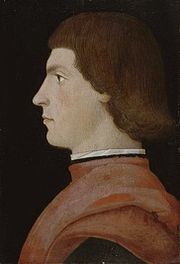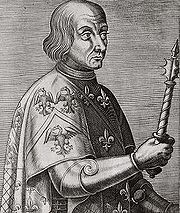
Louis II de la Trémoille
Encyclopedia

France
The French Republic , The French Republic , The French Republic , (commonly known as France , is a unitary semi-presidential republic in Western Europe with several overseas territories and islands located on other continents and in the Indian, Pacific, and Atlantic oceans. Metropolitan France...
general. He served under three kings: Charles VIII
Charles VIII of France
Charles VIII, called the Affable, , was King of France from 1483 to his death in 1498. Charles was a member of the House of Valois...
, Louis XII
Louis XII of France
Louis proved to be a popular king. At the end of his reign the crown deficit was no greater than it had been when he succeeded Charles VIII in 1498, despite several expensive military campaigns in Italy. His fiscal reforms of 1504 and 1508 tightened and improved procedures for the collection of taxes...
, and Francis I
Francis I of France
Francis I was King of France from 1515 until his death. During his reign, huge cultural changes took place in France and he has been called France's original Renaissance monarch...
. He was killed in combat at the Battle of Pavia
Battle of Pavia
The Battle of Pavia, fought on the morning of 24 February 1525, was the decisive engagement of the Italian War of 1521–26.A Spanish-Imperial army under the nominal command of Charles de Lannoy attacked the French army under the personal command of Francis I of France in the great hunting preserve...
.
Titles
During the course of his career, he earned the titleTitle
A title is a prefix or suffix added to someone's name to signify either veneration, an official position or a professional or academic qualification. In some languages, titles may even be inserted between a first and last name...
s Vicomte de Thouars, Prince de Talmond
Talmont-sur-Gironde
Talmont-sur-Gironde is a commune in the Charente-Maritime department in the Poitou-Charentes region in southwestern France.-Geography:The village lies about south of Royan, on a small promontory which dominates the Gironde Estuary. It appears to be ‘perched’ on this rocky outcrop, in the way that...
, Comte de Guînes et de Bénon, Baron de Sully, de Craon, de Montagu, de Mauléon et de l'Ile-Bouchard, Seigneur des Iles de Ré, de Rochefort et de Marans, and Premier Chambellan du Roi.
Military career
He was born in ThouarsThouars
Thouars is a commune in the Deux-Sèvres department in western France.It is on the River Thouet. Its inhabitants are known as Thouarsais.-History:...
to a prominent noble family of Poitou
Poitou
Poitou was a province of west-central France whose capital city was Poitiers.The region of Poitou was called Thifalia in the sixth century....
.

Brittany
Brittany is a cultural and administrative region in the north-west of France. Previously a kingdom and then a duchy, Brittany was united to the Kingdom of France in 1532 as a province. Brittany has also been referred to as Less, Lesser or Little Britain...
for the French crown after internal revolts had weakened Francis II, Duke of Brittany during the so-called "Mad War
Mad War
The Mad War , also known as the War of the Public Weal, was a late Medieval conflict between a coalition of feudal lords and the French monarchy. It occurred during the regency of Anne of Beaujeu in the period after the death of Louis XI and before the majority of the young king Charles VIII...
" (La Guerre Folle). His decisive victory at the Battle of Saint-Aubin-du-Cormier
Battle of Saint-Aubin-du-Cormier (1488)
The Battle of Saint-Aubin-du-Cormier took place on July 28, 1488, between the forces of king Charles VIII of France, and those of Francis II, Duke of Brittany and his allies. The defeat of the latter signalled the end to the "guerre folle" , a feudal conflict in which French aristocrats revolted...
on 27 July 1488 ended effective Breton independence.
He took part in several battles in the Italian Wars, notably the inconclusive Battle of Fornovo
Battle of Fornovo
The Battle of Fornovo took place 30 km southwest of the city of Parma on 6 July 1495. The League of Venice was able to temporarily expel the French from the Italian Peninsula. It was the first major battle of the Italian Wars.-Antecedents:...
(1495) and the victorious Battle of Agnadello
Battle of Agnadello
The Battle of Agnadello, also known as Vailà, was one of the more significant battles of the War of the League of Cambrai and one of the major battles of the Italian Wars....
(1509). He suffered a severe defeat at the Battle of Novara
Battle of Novara (1513)
The Battle of Novara was a battle of the War of the League of Cambrai fought on June 6, 1513, near Novara, in Northern Italy.The French had been victorious at Ravenna the previous year. Nevertheless, the French under King Louis XII were driven out of the city of Milan the following month by the...
, in which his 10,000-strong army was ambushed by 13,000 Swiss mercenaries.
He later went on to secure a French victory at the Battle of Marignano
Battle of Marignano
The Battle of Marignano was fought during the phase of the Italian Wars called the War of the League of Cambrai, between France and the Old Swiss Confederacy. It took place on September 13 and 15, 1515, near the town today called Melegnano, 16 km southeast of Milan...
(1515), but he perished at the Battle of Pavia
Battle of Pavia
The Battle of Pavia, fought on the morning of 24 February 1525, was the decisive engagement of the Italian War of 1521–26.A Spanish-Imperial army under the nominal command of Charles de Lannoy attacked the French army under the personal command of Francis I of France in the great hunting preserve...
on 24 February 1525, where he died of a wound inflicted by an arquebus
Arquebus
The arquebus , or "hook tube", is an early muzzle-loaded firearm used in the 15th to 17th centuries. The word was originally modeled on the German hakenbüchse; this produced haquebute...
. His death occurred during the climax of the battle when the French were surprised by 1500 Spanish arquebusiers. La Trémoille and other high-ranking Frenchmen fought their way towards their king, Francis I
Francis I of France
Francis I was King of France from 1515 until his death. During his reign, huge cultural changes took place in France and he has been called France's original Renaissance monarch...
, in order to protect him. La Trémoille fell from his horse, shot through the heart.
Marriage
On 28 July 1484, he married Gabrielle de Bourbon, daughter of Louis I, Count of MontpensierLouis I, Count of Montpensier
Louis de Bourbon was the third son of John I, Duke of Bourbon and Marie de Berry, Duchess d'Auvergne; Count of Montpensier, Clermont-en-Auvergne and Sancerre and Dauphin of Auvergne, brother of Charles I of Bourbon...
, by whom he was the father of Charles I de la Trémoille (father of François II de La Trémoille
François II de La Trémoille
François de La Trémoille was a French nobleman of the La Tremoille family. He was the son of Charles I de la Trémoille and of Louise de Coëtivy, and the grandson of Louis II de la Trémoille and of Gabrielle de Bourbon.-Titles:He held the title of 36th vicomte of Thouars...
by his wife, Louise de Coëtivy).
On 7 April 1517, Louis II de la Trémoille married 16 year-old Louise Borgia, Duchess of Valentinois, the only legitimate child of Cesare Borgia
Cesare Borgia
Cesare Borgia , Duke of Valentinois, was an Italian condottiero, nobleman, politician, and cardinal. He was the son of Pope Alexander VI and his long-term mistress Vannozza dei Cattanei. He was the brother of Lucrezia Borgia; Giovanni Borgia , Duke of Gandia; and Gioffre Borgia , Prince of Squillace...
, Duke of Valentinois by his French wife Charlotte of Albret
Charlotte of Albret
Charlotte of Albret, suo jure Dame de Châlus, Duchess of Valentinois , also known as Charlotte d'Albret, was a wealthy French noblewoman of the Albret family. She was the sister of King John III of Navarre, and the wife of the notorious Cesare Borgia whom she married in 1499...
. The marriage was childless. Five years after La Trémoille's death she married Philippe de Bourbon, Seigneur de Bourbon-Busset, by whom she had issue.

